Charger Tenergy T4s
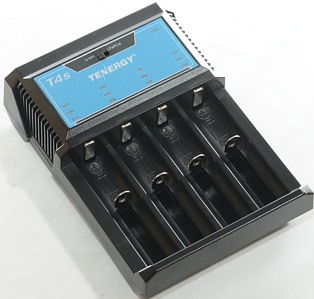
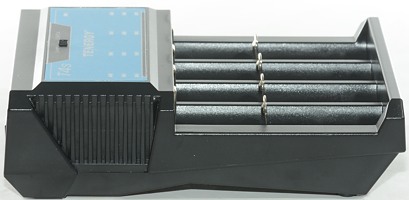
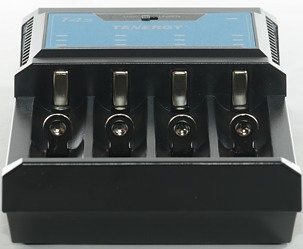
Tenergy sells batteries and chargers. I bought one of their more advanced chargers with 4 channels and support for 2 LiIon chemistries and NiMH.
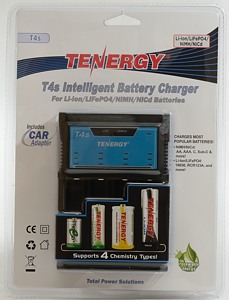
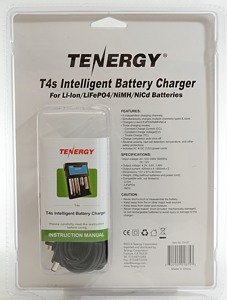
I got the charger in a blister pack with specifications on back (Click for larger version).
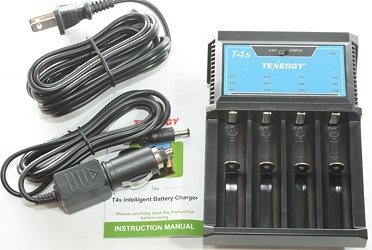
The box contained the charger, a mains cable, car adapter and a instruction sheet.
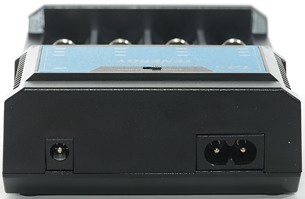
The charger has both a mains power input socket and a 12V barrel connector.
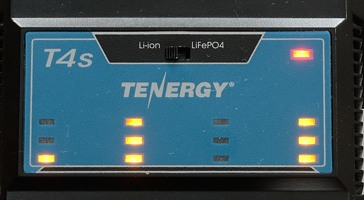
The user interface is a couple of leds and one switch:
3 yellow leds for each channel, while charging one will be flashing and the other will show charge state. When finished all will be steady lit.
If the charger detects and error all 3 yellow leds will flashes.
A red power led.
The switch is used to select between 4.2 volt and 3.6 volt charge voltage, i.e. normal LiIon or LiFePO4 cells. It is ignored for NiMH cells.
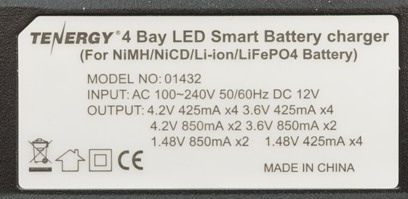
As can be seen on the label the charger has two charge currents depending on the number of batteries in it.
Slot #1 and #3 are paired, use both of them and the current drop
Slot #2 and #4 are paired, use both of them and the current drop
Even a full battery in one of the slots will drop the current in a paired slot.

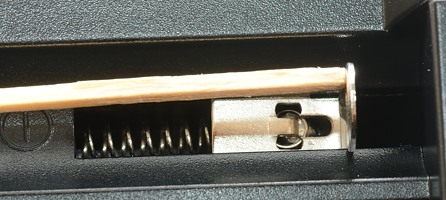
The charge uses the typical slider construction with a metal rail and it works very well from about 30mm to 71mm, i.e. the charger can handle just about any protected 18650 and 26650 cell.
The spring is a bit tight, this gives good connection when charging short cells.


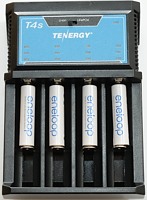
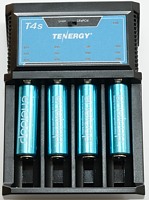
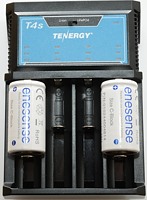

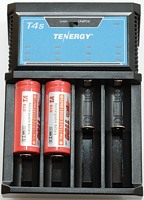
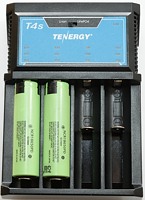
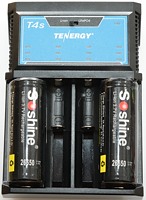
The charger can handle 71 mm long batteries, including flat top cells.
The charge current is 0.9A with a single battery, this is to much for many smaller cells.
Having cells in paired slots will bring 14500 and 16340 into the allowable range.
Measurements
- Power consumption when idle 0.53 watt.
- When only using slot #1 and #4 (or #2 and #3) the charge current is 0.9A
- When using slot #1 and #3 the charge current for these slots drops to 0.4A
- When using slot #2 and #4 the charge current for these slots drops to 0.4A
- Current will change between 0.4A and 0.9A as batteries are inserted and removed.
- Switch is used to select between 3.6V and 4.2V charging.
- Charger will start charging from about 0V, but abort to fail mode if voltage stays at 0V. The voltage must be above 0.5V for the charger to continue.
- Charger will always use full current.
- Above 2.3 volt the charger assumes LiIon batteries.
- The charger will not restart if battery voltage drops.
- Charge will restart charging after power loss, or battery insertion.
- When not connected to power it will drain about 1mA from a LiIon and 0.2mA from a NiMH battery.
Charging LiIon 4.2V
%20%231.png)
The charger uses a simulated CC/CV charging, but the CV phase starts a bit early and is rather slow. This does not prevent the charger from doing a nice charge, but it could have been faster. The termination current is around 50mA.
%20%232.png)
%20%233.png)
%20%234.png)
The 3 other slots are the same, all needs between 5½ and 6 hours to charge a 3100mAh cell. A better CC/CV charge curve could reduce the charge time with more than one hour.
%20%231.png)
%20%231.png)
No surprise with these two cells.
%20%231.png)
This older cells forces the charger into CV charge nearly from the start.
%20%231.png)
This cell is handled fine, but the initial current would have been more acceptable (lower) if I had put a cell in slot #3 also.
.png)
With four batteries and using internal power supply the charger do get warm.
.png)
Using external power supply reduces the heat.
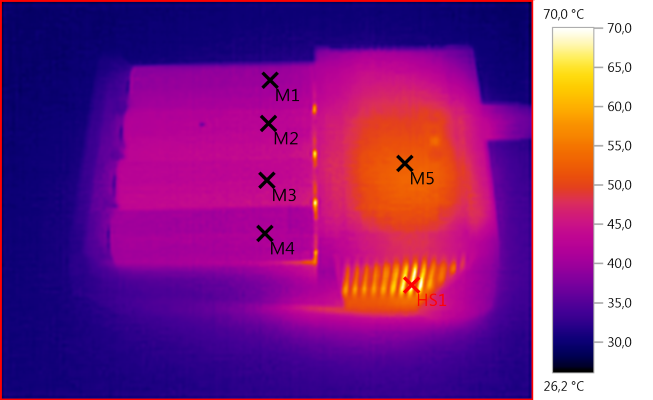
M1: 40,0°C, M2: 42,5°C, M3: 43,8°C, M4: 41,7°C, M5: 52,4°C, HS1: 70,0°C
None of the batteries are to warm and as usual there is some electronic inside the charger that gets fairly hot.

M1: 36,5°C, M2: 39,2°C, M3: 39,9°C, M4: 36,6°C, M5: 49,3°C, M6: 49,6°C, HS1: 56,8°C

The charger needs about 3 second to start charging.
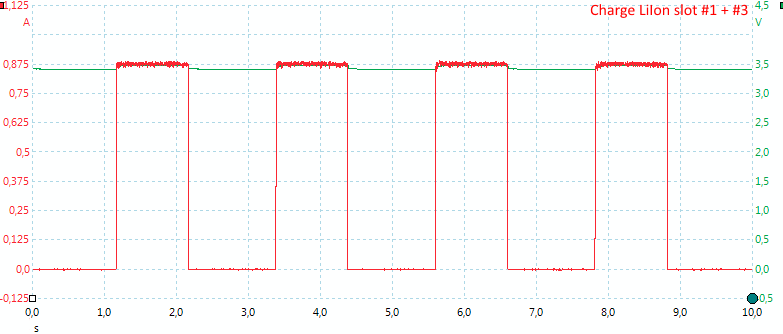
When paired slots are used each charge circuit is time shared between two slots, the charts here is from slot #1
Charging LiIon 3.6V (LiFePo4)
With the switch in LiFePo4 position the charger will only charge to 3.6 volt.
%20%231.png)
The charge current is a bit low, but with the usual low capacity of LiFePO4 cells it is not really a problem.
The actual charging looks fine.
%20%231.png)
A smaller cell is also charged fine.
Charging NiMH
%20%231.png)
Nice charging, it looks like the charger uses -dv/dt detection and stops when the battery is full. This is good.
%20%232.png)
%20%233.png)
%20%234.png)
The 3 other channels works the same way.
%20%231.png)
%20%231.png)
The two high capacity cells are also handled fine.
%20%231.png)
Same with the AAA, but again it would have been a good idea with a cell in slot #3 to reduce the current.
%20%231.png)
The detection for a full cell is often very slow with -dv/dt termination, but 10 minutes is fairly fast.
.png)
With 4 cells in the charger the current is reduced, this makes -dv/dt termination difficult and the charger fails to detect a full cell (bad).
The cell with the temperature sensor on is detected and current turned off.
.png)
Another run with an external power supply and this time the full cell is detected.
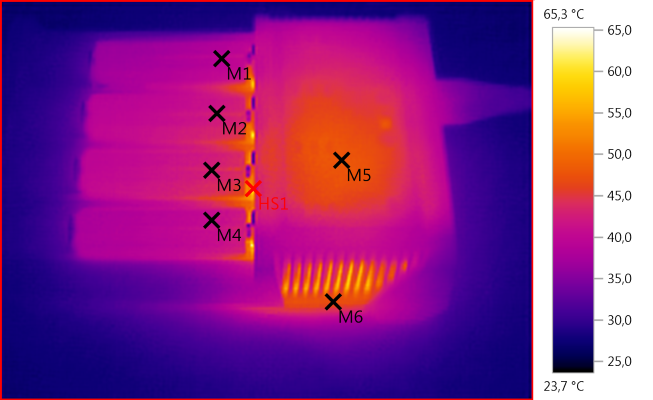
M1: 39,5°C, M2: 43,2°C, M3: 43,3°C, M4: 40,8°C, M5: 48,1°C, M6: 47,0°C, HS1: 65,3°C

The charger needs about 3 seconds to start.
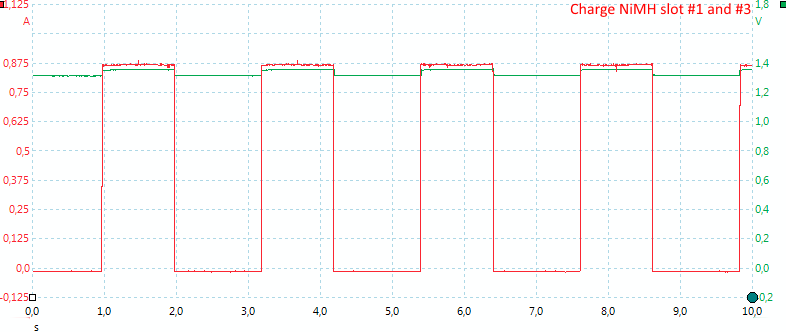
With cells in slow #1 and #3 the charger will time share the charge current between them.
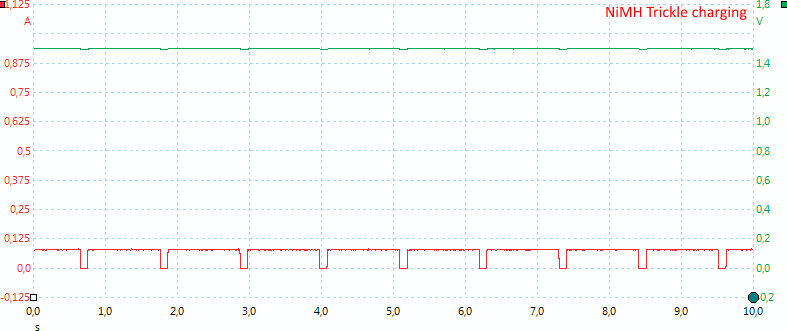
Trickle charge is done with a low current, not current spikes, but it is rather high for LSD cells.
Testing the mains transformer with 2500 volt and 5000 volt between mains and low volt side, did not show any safety problems.
Conclusion
The charger does a good job charging LiIon, but it a bit slow. It is nice with support for LiFePO4 and the switch is on the front where it is visible.
The charge current is too high for small cells, using an extra cell the current can be reduced. It would have been nice if the center slots always was low current or there was a switch to select low current.
With NiMH the charger has a very good termination at full current, but can miss termination with low current (i.e. many cells in the charger). The trickle charger is on the high side, i.e. it is a good idea to remove the NiMH batteries within a few hours when they are finished charging.
I will call this charger acceptable.
Notes
Here is an explanation on how I did the above charge curves: How do I test a charger




















%20%231.png)
%20%232.png)
%20%233.png)
%20%234.png)
%20%231.png)
%20%231.png)
%20%231.png)
%20%231.png)
.png)
.png)




%20%231.png)
%20%231.png)
%20%231.png)
%20%232.png)
%20%233.png)
%20%234.png)
%20%231.png)
%20%231.png)
%20%231.png)
%20%231.png)
.png)
.png)



